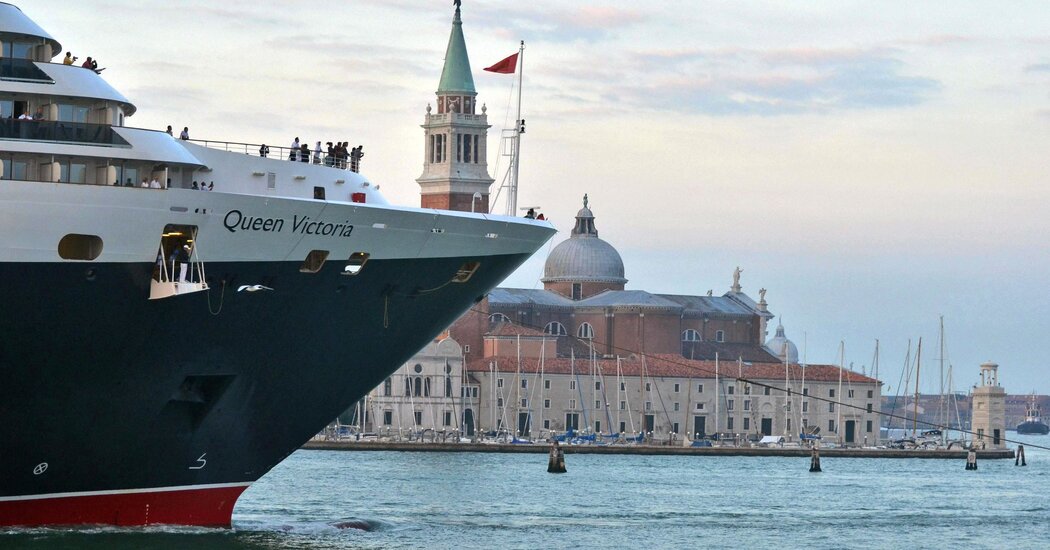ROME — The coronavirus pandemic has kept most cruise ships docked. But the Italian government ruled this week that even when voyages resume, gigantic cruisers will no longer be permitted to pass Venice’s St. Mark’s Square and must find berthing outside its fragile lagoon.
Citing the need to protect the “artistic, cultural and environmental heritage of Venice,” the Italian cabinet passed a decree late Wednesday calling for “urgent provisions” to detour cruise activities and freight traffic. The government mandated that Venice’s port authority issue a public consultation — described as a “call for ideas” — to find alternative ports to handle large container ships and cruise ships over 40,000 tons and planned to build a terminal outside the lagoon.
Dario Franceschini, Italy’s culture minister, praised the decision on Thursday, citing the shock of visitors to Venice upon seeing cruise ships “hundreds of meters long and as tall as apartment buildings,” passing in front of St. Mark’s Square. He said the government’s decision had been influenced by UNESCO, the cultural protection agency of the United Nations, which had long called on Italy to reconcile the balancing of lagoon preservation with the economics of cruise and freight activity.
The government’s decision was welcomed by environmental associations that have been warning about the havoc that large ships have been wreaking on the Venetian lagoon as they make their way down the Giudecca Canal to dock at the city’s main passenger canal.
“We won: ‘big ships out of the lagoon’ it’s a law,” the No Big Ships Committee proclaimed on its Facebook page. After years of protests, marches, initiatives and trials against committee members, the government had sided with the voices of the city: “Big ships are not compatible with the Venetian Lagoon,” the committee wrote.
Their concerns rang loudest whenever ship-induced accidents shone a spotlight on the big ship issue, including a June 2019 accident when a cruise liner crashed into a smaller tour ship and a wharf on the Giudecca Canal.
But even as environmentalists said they felt vindicated by the government’s decision, they expressed concerns about the government’s plans to temporarily detour cruise ships to the port of Marghera, the industrial hub on the lagoon, until the new mooring station outside the lagoon is built.
“This is the first time that a government has issued a formal decree banning ships from the lagoon, and this is without doubt enormously positive,” said Tommaso Cacciari, a spokesman for the No Big Ships Committee.
“But then the government messes up immediately after,” he said, because “it speaks of temporary solutions in Marghera.”
Mr. Cacciari said that such solutions could end up lasting years and that a terminal in Marghera would not be feasible because of logistical and environmental concerns.
The state of Venice’s fragile lagoon has increasingly come under scrutiny in recent years as violent storms and frequent floods have ravaged the city.
UNESCO said in an email that its World Heritage Committee had been in “constant dialogue with the Italian authorities to find a suitable solution.” The agency is considering adding Venice to its list of world heritage in danger, unless measures are taken for “significant and measurable progress in the state of conservation” .
The government had previously ruled that big ships had to find an alternative route to avoid fragile areas like the Venetian Lagoon. Other initiatives include a project for an offshore terminal and a permanent passenger terminal at the Lido entrance to the lagoon.
The Lido project was approved by several government committees but has languished at the infrastructure ministry. Cesare De Piccoli, a former lawmaker from Venice involved with the project, said he that had not been informed about the reasons for the limbo but that the latest decision to ban ships from the lagoon was “politically important.”
Given his own experience, Mr. De Piccoli expressed skepticism but said he planned to re-pitch the Lido project as part of the call for ideas.
“After all, it’s already been approved,” he said.
Critics said the decision to detour ships to Marghera, even if temporary, went against the spirit of the government decree.
Some were concerned that the canal used by freight ships, which was built in the 1960s, was both too narrow and shallow to handle current big ships. The recent Suez Canal episode “should provide ample warning,” said Senator Mauro Coltorti, the president of the Senate transport and public works commission.
Others feared that spending millions on a passenger terminal risked making it permanent.
Still others worried that the canal leading to Marghera would have to be enlarged to accommodate large ships, “which would be a kick in the stomach” to environmental initiatives, said Maria Rosa Vittadini, a retired professor at the University of Venice.
Cinzia Zincone, the commissioner for the port authority that oversees the port of Venice, said the canal required maintenance, as its banks were eroding and “important sediment” was sinking into the canal. “We can’t permit this to continue because it negatively impacts on the environment,” she said.
Some Venetians wondered how international cruise ship travelers would feel about docking in Marghera, which is unequivocally not scenic. “You’re going to have tourists that think they’re going to see St. Mark’s but find themselves in front of an oil refinery,” Mr. De Piccoli said.
